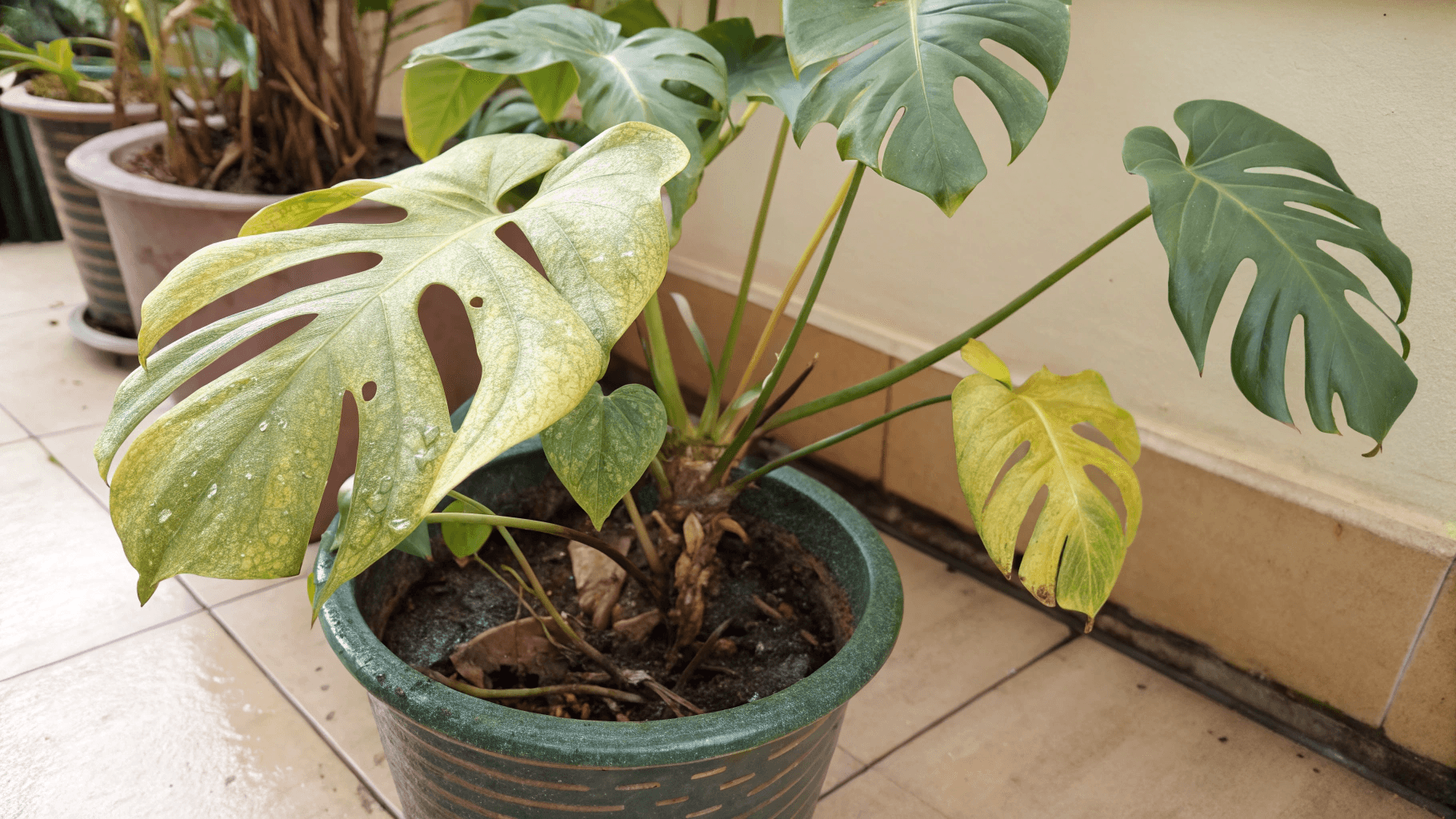Even though Monstera are considered easy-to-care-for plants, it’s easy to make mistakes that can stress them out. Whether your Monstera is showing yellow leaves, stunted growth, or even losing its iconic holes and splits, the cause is often simple, but tricky to spot if you’re new to plant parenting.
Let’s cover the most common Monstera care mistakes and, more importantly, how to fix them so your plant thrives.
Table of Contents
#1 Too Much or Too Little Light

Signs Your Monstera Needs Better Light
Monstera deliciosa thrives in bright, indirect light. But sometimes, the light your plant is getting isn’t quite right.
- Too much light: Leaves may turn yellow or develop brown, crispy edges. You might notice sunburned patches on your foliage.
- Too little light: Growth slows down, leaves lose their fenestrations (the iconic splits and holes), and the plant becomes leggy with long stems and sparse leaves.
How to Fix Light Issues
- For too much light: Move your Monstera a few feet away from direct sunlight, or use sheer curtains to diffuse harsh rays.
- For too little light: Relocate your plant near a bright window. If natural light is limited, consider using a grow light to supplement. Even 12–14 hours a day of indirect or artificial light can help restore proper growth.
TIP: Rotate your Monstera every few weeks to ensure all sides get equal light exposure. This prevents uneven growth and keeps the leaves lush and symmetrical.
#2 Overwatering or Underwatering

Watering is one of the most common areas where Monstera owners go wrong. Both overwatering and underwatering can cause serious stress.
Signs of Overwatering
- Yellowing leaves that feel soft or mushy.
- Soil that smells sour or rotten.
- Roots that are brown and slimy (root rot).
Signs of Underwatering
- Crispy, brown leaf edges.
- Leaves drooping or curling.
- Dry, compacted soil that pulls away from the edges of the pot.
How to Fix Watering Mistakes
- Check your soil: Monstera prefers slightly moist but well-draining soil. Use a mix with peat, perlite, and orchid bark to retain some moisture without waterlogging roots.
- Watering technique: Let the top 2–3 inches of soil dry out before watering again. Stick your finger in the soil; if it feels dry, it’s time to water.
- Repot if needed: If overwatering has caused root rot, remove the plant from its pot, trim the damaged roots, and repot in fresh, well-draining soil.
TIP: Always water slowly and evenly, allowing excess to drain from the bottom. Never let your Monstera sit in standing water, as this invites rot and fungal issues.
#3 Poor Soil or Pot Drainage

Even with the right watering schedule, poor soil or pots without drainage can sabotage your Monstera.
Signs of Soil or Drainage Problems
- Water pools at the top or bottom of the pot.
- Slow growth despite proper light and watering.
- Stressed leaves (yellowing or wilting).
How to Improve Soil and Drainage
- Use well-draining soil: A mix of potting soil, perlite, and orchid bark works best for Monsteras. This keeps roots aerated and reduces the risk of rot.
- Choose the right pot: Always use a pot with drainage holes. If your decorative pot doesn’t have holes, consider using it as a cachepot. Place the Monstera in a drainage-friendly pot inside the decorative one.
- Add a layer of drainage material: Small stones or clay pebbles at the bottom can help excess water escape.
By giving your Monstera the right soil and pot, you’re setting it up for long-term health and growth.
#4 Pests and Diseases

Even hardy plants like Monstera can fall victim to pests and diseases. Spotting these early is key.
Common Pests
- Mealybugs: White, cottony clusters on leaves and stems. They suck sap, weakening the plant.
Fix: Wipe affected areas with a cotton ball dipped in rubbing alcohol or use insecticidal soap. - Spider mites: Tiny red or brown specks, often leaving webbing.
Fix: Increase humidity and spray the plant with water regularly. For severe infestations, insecticidal soap works well. - Scale insects: Brown, oval bumps on stems and leaves.
Fix: Scrape them gently off and treat with neem oil or insecticidal soap.
Common Diseases
- Root rot: Caused by overwatering and poor drainage. Look for black, mushy roots and foul soil odor.
Fix: Remove affected roots and repot in fresh, dry soil. Avoid overwatering in the future. - Fungal leaf spots: Brown or black spots on leaves, often with a yellow halo.
Fix: Remove affected leaves and ensure proper airflow around the plant. Fungicide can help in severe cases.
TIP: Always isolate a sick Monstera from other plants to prevent pests or diseases from spreading.
#5 Common Aesthetic Issues

Sometimes your Monstera isn’t dying, it’s just not looking its best. Here’s why.
Yellow Leaves
- Cause: Overwatering, nutrient deficiency, or old leaves naturally dying.
- Fix: Adjust watering, check soil quality, and consider feeding with a balanced houseplant fertilizer every 4–6 weeks during the growing season.
No Fenestration (No Holes or Splits)
- Cause: Low light, juvenile plant, or stress from improper watering.
- Fix: Increase indirect light exposure and maintain consistent care. Some Monstera develop fenestrations only as they mature.
Leggy Growth
- Cause: Plant stretching toward a light source or insufficient support.
- Fix: Rotate regularly, provide a moss pole or stake for climbing, and trim overly long stems to encourage fuller growth.
Browning Leaf Edges
- Cause: Low humidity or inconsistent watering.
- Fix: Increase humidity by misting, using a pebble tray, or investing in a humidifier. Keep watering consistently.
Final Thoughts on Monstera Care Mistakes
Monsteras are incredible plants, but even “easy” plants need thoughtful care. Most issues, yellowing leaves, leggy stems, or slow growth, can be traced back to light, water, soil, or pests.
By identifying the problem early and applying the fixes outlined here, your Monstera will thrive and continue to be the lush centrepiece of your home.


 ChatGPT
ChatGPT
 Perplexity
Perplexity
 Claude
Claude
Leave a Reply